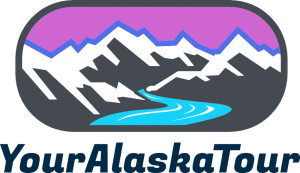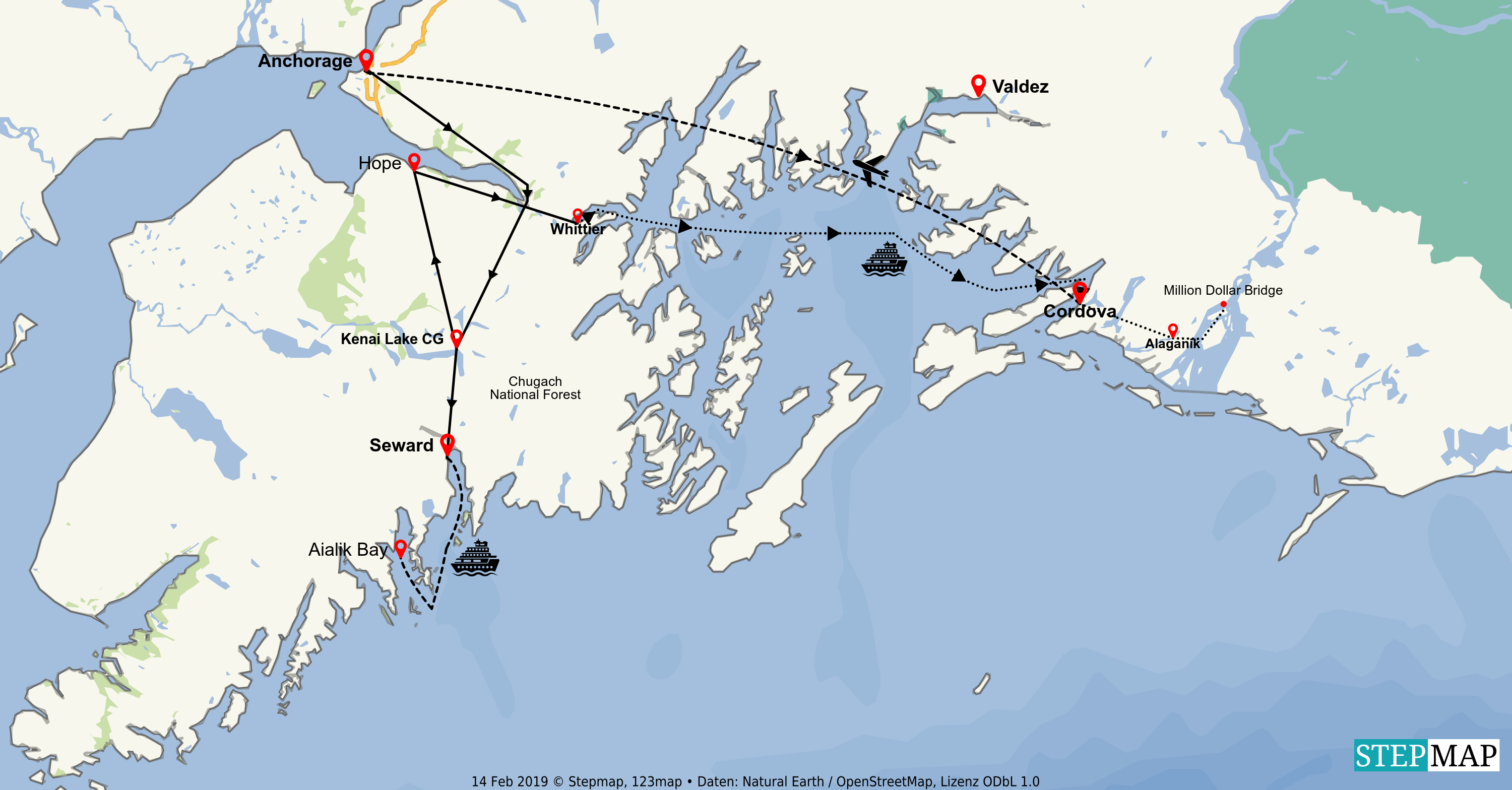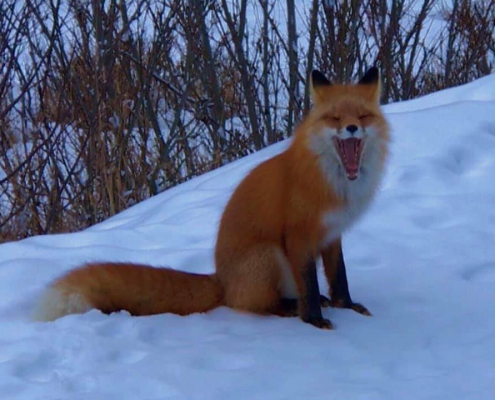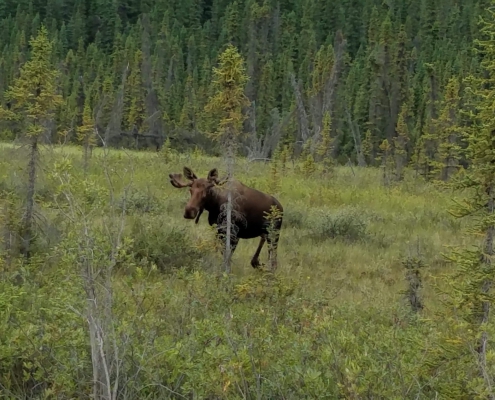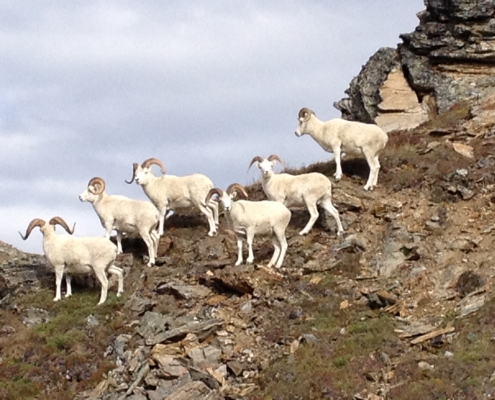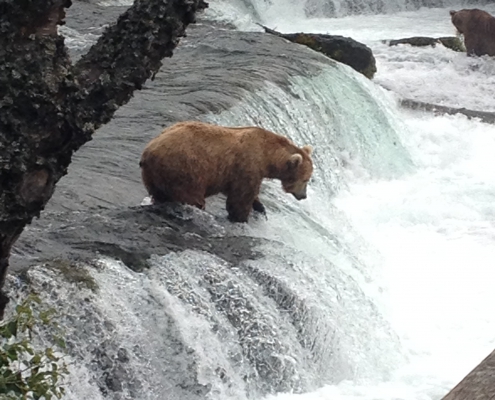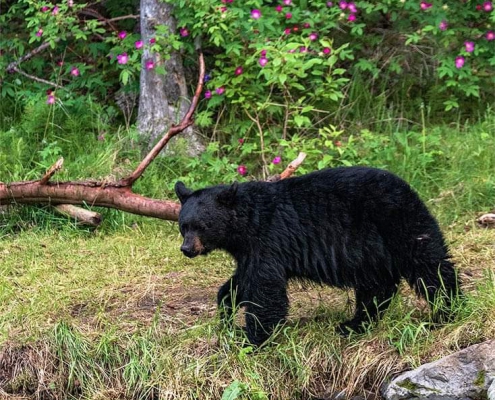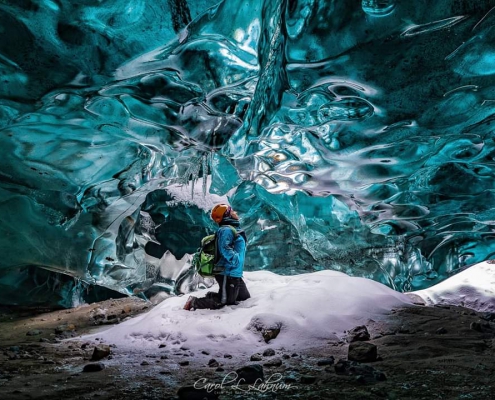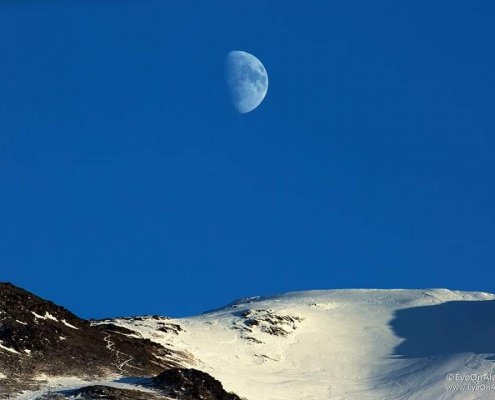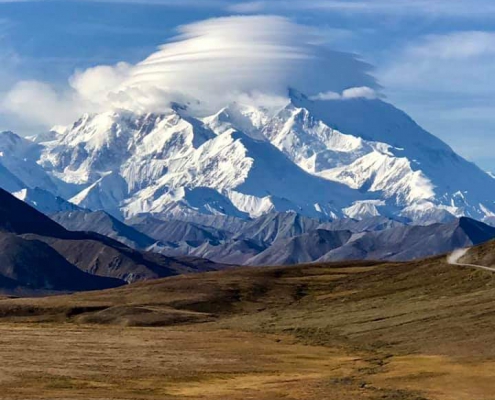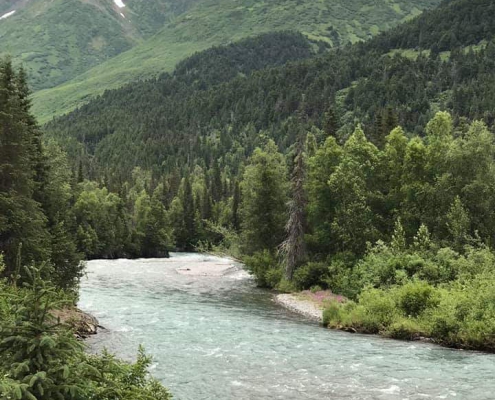Alaska SEA to SOUND
Highlights and Overview

The Alaska Sea to Sound tour showcases Alaska’s vibrant and dynamic coastal habitat, from the Kenai Fjords outside of Seward to the secluded fishing village of Cordova on the far eastern edge of Prince William Sound.
This action packed itinerary travels by road, by water and finally by air to visit the most memorable sights within Alaska’s stunning south central coastal landscape.
A glacier cruise, a whitewater rafting trip, an overnight sea kayak excursion and a day on the ferry are all part of a uniquely rewarding week long exploration of Alaska’s seaward side where you will never be far from the scent of salt water in the air or the call of eagles overhead. Orcas, whales, tidewater glaciers, grand and wild rivers and dreamlike northern rain forests are all part of the week long AK Sea to Sound adventure.
Highlights of the AK Sea to Sound
Alaska Sea to Sound Tour Map
AK SEA to SOUND Day to Day program
⇒ 7 day tour, small group up to 10 people
⇒ Starts on SUNDAY, finishes SATURDAY
see dates & prices 2020
Day 1: Kenai Fjords National Park
Drive from Anchorage to Seward (120 miles, approx. 2 hours)
Kenai Fjords National Park tour (6 hour tour to Aialik Bay)
Camp
Your Alaska Sea to Sound tour begins with a morning pick up from your Anchorage accomodations, followedby a two hour drive south on one of America’s most scenic routes to Seward. An idyllic little town nestled at the head of Resurrection Bay, Seward is the gateway to the Kenai Fjords National Park. From the small boat harbor we will leave our vehicle behind and board a sightseeing vessel to explore this National Park inaccessible by road.
A day long glacier cruise will show you this amazing landscape, protected as a national park since 1980. The Kenai Fjords is a place where mountains literally crumble to the sea, where a complex geological history is revealed in a dynamic array of rocky coves, sheer spires of stone and scattered islands. Rock that first met the sea as volcanic magma has been slowly driven northward by plate tectonics until finally meeting the North American plate to add another piece to the puzzle we now call Alaska. As the planet cooled into the Ice Age the great glaciers of the north formed, and although much of the ice has retreated the tidewater glaciers of the Kenai Fjords still soar many stories over the deep water fjords they once carved out. Cold and deep, the waters of offshore Alaska contain a sunken treasure of biomass that forms the building blocks of the pacific ocean food chain. Hundreds of hungry humpback whales migrate from their breeding grounds off the Baja peninsula to the Kenai Fjords every summer to feed, their passage in turn attracting the predatory orca pods that prey upon them.
Whales, or orcas, or both are usually seen on the Kenai Fjords day long glacier cruise, certainly a highlight of the voyage. But for many visitor’s to the Kenai Fjord the ultimate highlight is the time spent before the face of one of the tidewater glaciers of Aialik Bay. Few experiences rival that of viewing a massive tidewater glacier firsthand, especially when it sheds tons of ice into the water with a thunderous crack like cannon fire and sets the placid ice strewn water alive with rolling waves. Known as calving, seeing the dynamic ice shedding of a tidewater glacier up close is an iconic Alaskan experience you must see to believe.
Where the ice has receded from the land the cycle of life has taken root. The jigsaw puzzle cliffs that jut impossibly out of the seawater provide habitat, nesting sites or simple landing spots, for a number of birds that call the northern pacific home in the summer months, especially the entertaining puffins. Dense forests have reclaimed the coastal mountain slopes, prime bear habitat, and the high grassy ridgelines are dotted with mountain goats.
The Kenai Fjords are truly a unique niche within Alaska’s mosaic of intact wilderness habitats and one you will not want to miss on your Alaskan trip.
After our return to Seward’s small boat harbor with some time to see the sportfishing catch of day on display, and explore the village a bit, we’ll make a short drive to our camp for the next two nights and prepare our dinner.
Day 2: Exit Glacier Hike
Drive to Exit Glacier (approx 35 miles, <1 hour)
Hike Harding Icefield Trail (4miles one way, approx 3,000 ft elevation gain)
Visit Seward after hike, (shower option at harbormaster) Dinner at local restaurant
Evening in camp
Day 2 we will explore the Kenai Fjords from its landward side, shake off our sea legs with one of Alaska’s most rewarding hikes, a climb through the lush northern rainforest to a viewpoint of the Harding Icefield, the largest icefield within the United States. The demanding day long hike climbs beside the Exit Glacier, offering the unique perspective of a glacier from above. Traversing the treeless slopes to the hike’s dramatic end point, a viewpoint overlooking the 400 square mile icefield, is a glimpse into the heart of the ice age.
Descending back to the trailhead with a hearty appetite we’ll enjoy an evening meal at one of Seward’s fine seafood restaurants at the harbor before returning to our camp.
Day 3: Whitewater Rafting or Hiking in Hope
Morning departure from Seward camp to Hope (1 hour drive)
Choice of day hiking from Hope or whitewater rafting
Evening in Hope, camp
Day 3 we will make the short drive north to where the road ends on the shore of the Turnagain arm and the tiny little town of Hope. Founded in the heyday of Alaska’s gold rush and optimistically named by the earnest prospectors who dreamed of sudden fortunes flowing down from the mountains above town, Hope is now the home of Alaska’s premiere whitewater run on what is known as the 6 mile creek. Launching out of the Kenai Mountains and gathering tributaries as it carves its way to tide water, the 6 mile progressively builds through three separate canyon, ultimately culminating in a class V third canyon. With an option to run just the first two canyons, or all three, the 6 mile trip offers the whitewater lover a memorable afternoon, from mild to wild. Aside from the rafting, great hiking opportunities surround the picturesque town of Hope, with either a coastal trail through the woods along the Turnagain Arm or an ambitious climb to Hope Point above town where, on a clear day, you are able to see three mountain ranges— the Chugach, the Alaska, and the Tordrillo mountains— from the single point.
Hiking or rafting, however you choose to spend your day in the outdoor loving enclave of Hope, an evening in the historic 100 year old pub, where the draft beer is served in mason jars and live music is often on tap, will be a welcome finish as you watch the midnight sun sort of set in the northern sky across the Turnagain Arm.
Day 4: Kayaking Prince Williams Sound
Drive to Whittier small boat harbor (50 miles, 1 hour plus tunnel allowance)
Visit Portage Lake enroute
Transfer to water taxi for overnight kayak camp in Blackstone Bay
Afternoon kayaking Blackstone Bay
Wilderness camp, dinner in Prince William Sound
After another short drive on day 4, we will return to sea via a converted railroad tunnel to make our way under the coastal range to reach the former war time supply depot known as Whittier. What made Whittier an essential naval base in WWII—a deep water port hidden in an arm of Prince William Sound—today makes it a perfect access point for water excursions into the Sound. From the small boat harbor in Whittier we will join with a sea kayaking team to travel into the Sound by water taxi where we will land on a remote beach and establish our base camp.
From there, we will spend the afternoon kayaking for a truly unique wilderness experience in a landscape of forests, mountains, glaciers and tides best experienced from sea level, from the cockpit of a kayak. A sound, by definition, is a body of water that connects or sits between two other bodies of water. Prince William Sound is a landscape of sea accretions that looks like a half assembled puzzle of islands strewn between a border of jagged fringe, where the mountainous mainland meets the ocean in a multitude of bays and fjords while the large southern islands of Hitchinbrook and LaTouche act as protective barriers against the massive open ocean swells of the Pacific.
In short, Prince William Sound offers a perfect combination of scenery and conditions to make sea kayaking readily accessible and vastly rewarding, perfectly suitable for the first time paddler. A night camped in the Sound surrounded by only salt water and sounds of the sea completes a perfect day in this special place.
Day 5: Ferry across Prince William Sound to Cordova
Morning kayak option, early
Water taxi return to Whittier harbor
AMH Ferry to Cordova
Dinner on ferry
Indoor accommodations in Cordova
Day 5 we will wake at our wilderness camp in the Sound and have time for breakfast and a morning paddle before breaking camp and returning with the water taxi back to Whittier for our afternoon departure aboard the Alaska Marine Highway Ferry across the whole of Prince William Sound to the fishing village at its southeastern corner known as Cordova.
A day long crossing, we’ll arrive in the ferry port in the early evening and transfer to our lodging to prepare for two days exploring this off the beaten path uniquely Alaskan area.
Day 6: Exploring Cordova
Hike Heney Ridge (6 miles one way, approx 2000 feet elevation gain)
Dinner in town, Indoor Accomodation
The salmon rich Copper River delta area was inhabited for 1000’s of years by the native Eyak people, but the name Cordova first appears on the Alaskan map at the dawn of the 1900’s with the discovery of the great copper reserves in the Wrangell Mountains. As the Kennecott Corporation began mining some of the purest copper ore ever discovered from the mountains at the Copper River’s headwaters, the challenge of how to move the mineral to market quickly arose as the riddle to be resolved. The nearly pure copper seams that rippled through the ridgeline and appeared to be green alpine meadows from below obviously contained ore of phenomenal value, but encased in mountains more than 200 miles from the ocean, in a completely undeveloped landscape of glacial rivers, icefields and dense northern forests, the task of moving the mineral to market to realize its wealth seemed insurmountable. Undaunted, the Kennecott Corporation moved ahead with ambitious plans for a railroad through the wilderness from the mountains to sea. But a suitable port also needed to be established and when winter storms destroyed their first ocean pier and a second route out of Valdez was scuttled, the skeptics who said the railroad was impossible to build seemed to be proved right. With time running out a seemingly impossible route paralleling the Copper River was chosen as the only hope even though it required construction of a bridge across the massive river between the faces of two gargantuan advancing glaciers in the dead of an Alaskan winter. Truly an engineering marvel of its time, with a price tag to match, the Million Dollar Bridge was completed in 1911 and the Copper River & North Western railroad (long derided as the “Can’t Run & Never Will”) began operation between the mill town of Kennecott and the newly developed port town on the shores of Prince William Sound, which was given the name Cordova.
The town and the copper trade flourished until the late 1930’s when a number of factors shut down the operation in Kennecott. Without the railroad, Cordova was no longer accessible overland. Plans to convert the old rail bed to a road were put into motion during the post war wave of Alaskan road development, but the massive ‘64 earthquake (at 9.2 the largest ever recorded in North America) scuttled this plan by collapsing a number of bridge spans along the route, including a section of the Million Dollar bridge.
With regular ferry service across the Sound, many Cordova residents are just fine with no road. Some even reacted to the abandoned road plan with relief. Though welcoming to visitors, Cordova is truly a working fishing village where the majority of the residents make their living from the sea and take a certain pride in being just a bit harder to reach. The extra effort required to reach Cordova is exactly why it is a special place to visit.
On the Alaska Sea to Sound we will spend two days exploring the rich natural habitat around Cordova, where the Copper River delta empties more than a fifth of Alaska’s overall freshwater into the northern pacific, receiving in return annual migrations in the millions of shorebirds, in the spring, and salmon, throughout the summer. From our base in Cordova we will travel the Copper River delta road to explore the easy hiking trails that lead into the lush coastal rainforests and stunning glacial lakes.
Day 7: Hike in Cordova & Flight back to Anchorage
Morning tour along Cordova road, short hike option
Late Afternoon return flight to Anchorage
On our final day in Cordova we will hike out of the harbor setting just south of town through the old growth coastal rainforest, progressively climbing from dense forest to bog meadows crossed by boardwalks until we surmount tree line and access the high ridge well above town. Named for the chief engineer of the CR&NW Railroad, the “Irish Prince” Mike Heney is said to have climbed this ridge to survey the railroad’s route through the delta’s maze. Though the railroad is long gone, the inspiring views from this ridge, sandwiched between the Copper River watershed to the east and the vast expanse of the islands and open water of the Sound to its west, remain.
A scenic hour long flight from Cordova’s commercial airport will return you to Anchorage and conclude the week long Alaskan Sea to Sound adventure.
Alaska Sea to Sound Tour – 7 days
Departures 2020
from/to Anchorage Sunday to Saturday
- June 14 – 20
- $2195 per person
- * single supplement $150 all dates
- July 5 -11
- $2195 per person
- * single supplement $150 all dates
- July 26 – August 1
- $2195 per person
- * single supplement $150 all dates
- August 9 – 15
- $2195 per person
- * single supplement $150 all dates
- August 30 – Sept 5
- $2195 per person
- * single supplement $150 all dates
What’s included?
- Kenai Fjords National Park cruise tour
- 4 nights camping / 2 nights hotel room in Cordova
- Kayak overnight camp with kayak & equipment
- Ferry from Whittier to Cordova
and also:
- Flight from Cordova to Anchorage
- 6x breakfast, 7x lunch, 3x dinner (3 dinners at restaurants not included)
- Full time experienced Alaska guide & transportation
- tent and sleepmat
Not included:
- transport to and from Anchorage (where tours start and end)
- Anchorage lodging, before or after the tour
- personal sleeping bag (available for rent with advance notice, $30 per tour)
- Non included meals (see day to day program) or alcoholic beverages
- optional activities (see day to day program)
- personal expenses & gratuities
- personal travel insurance (recommended)
